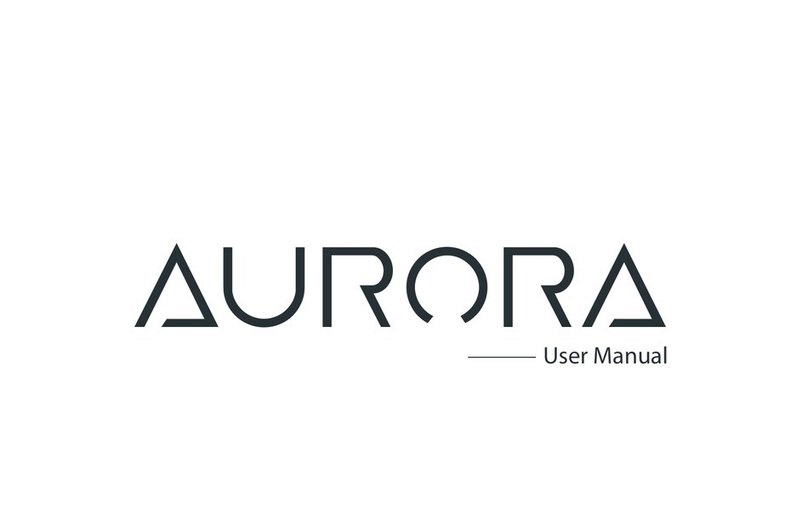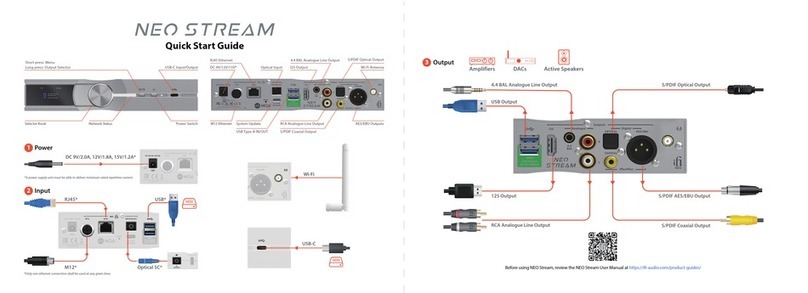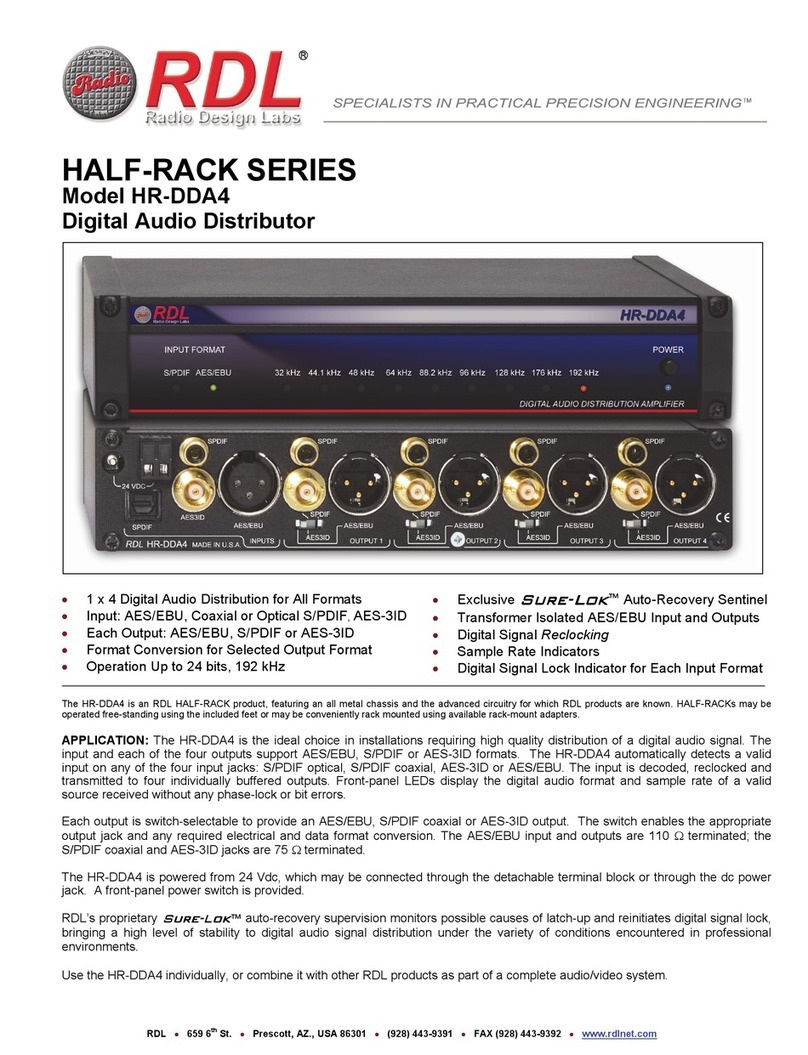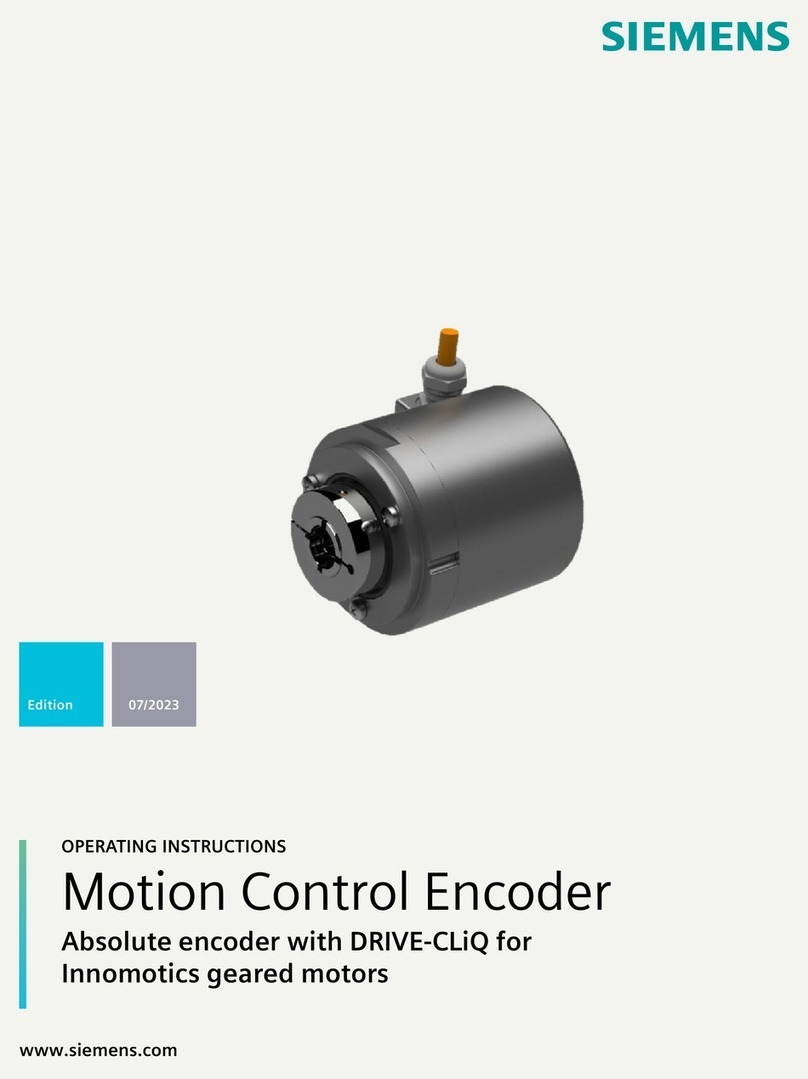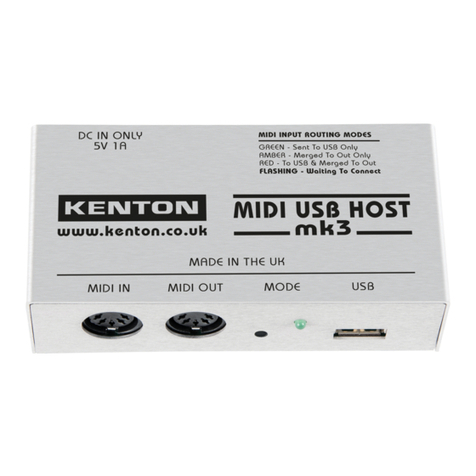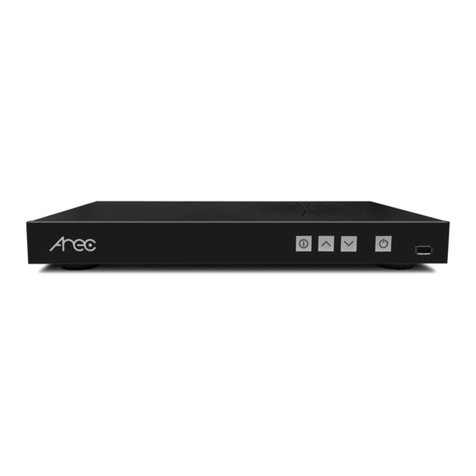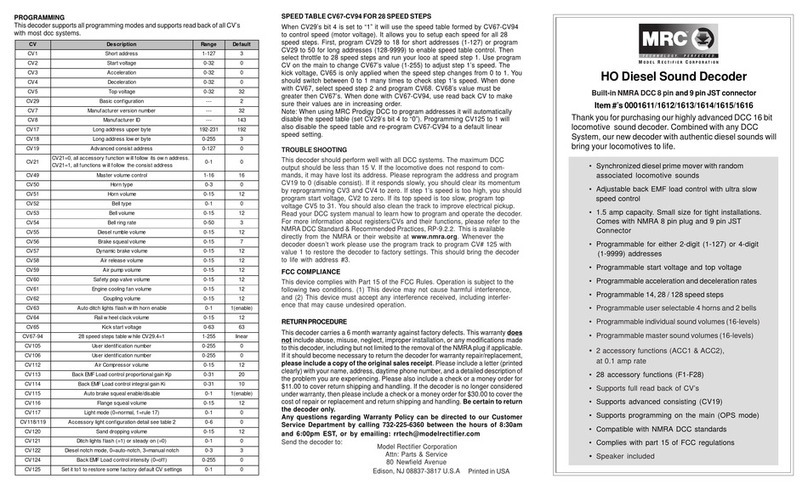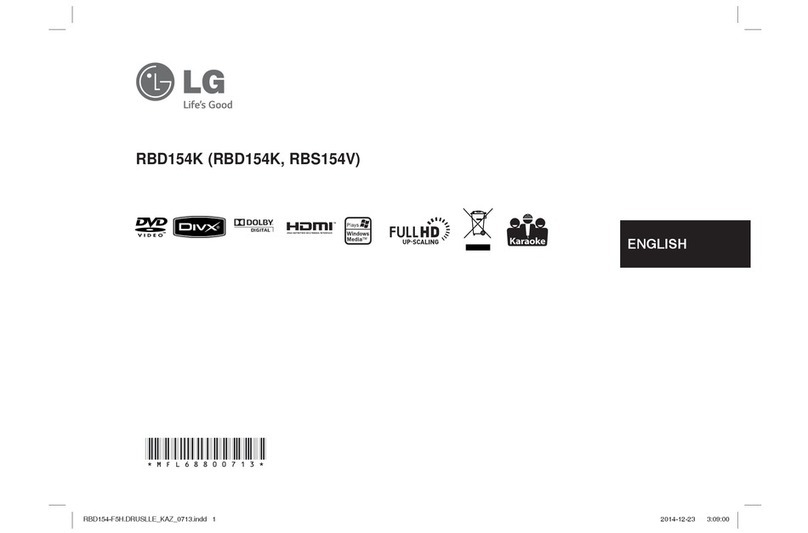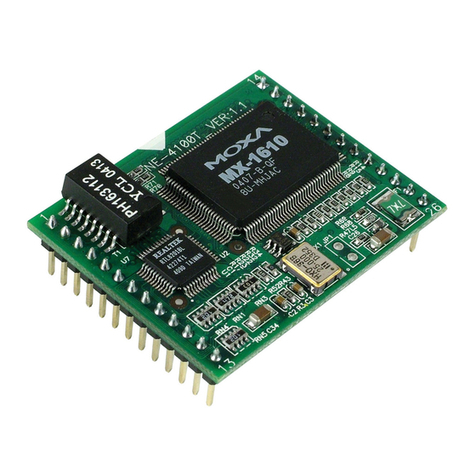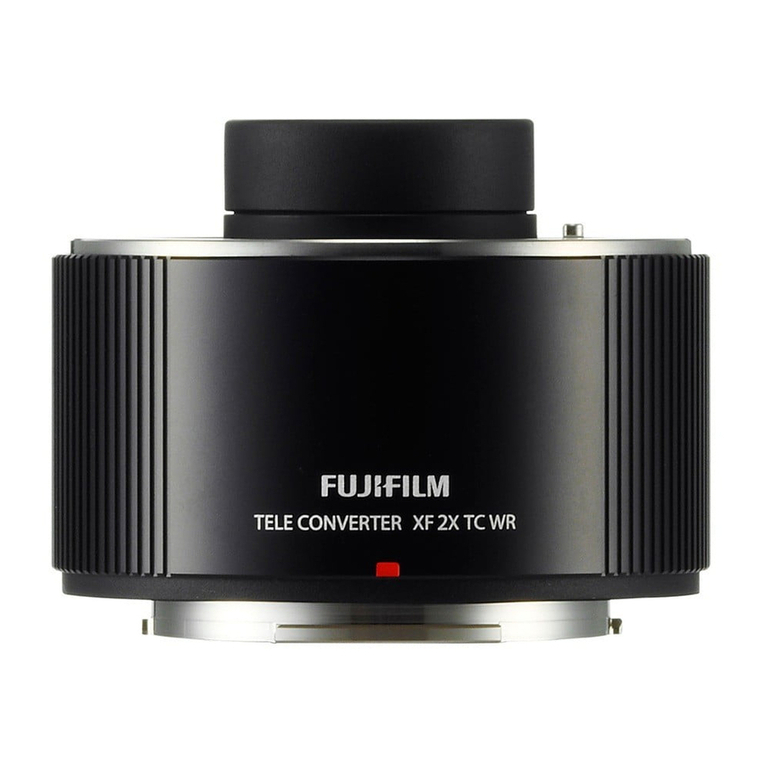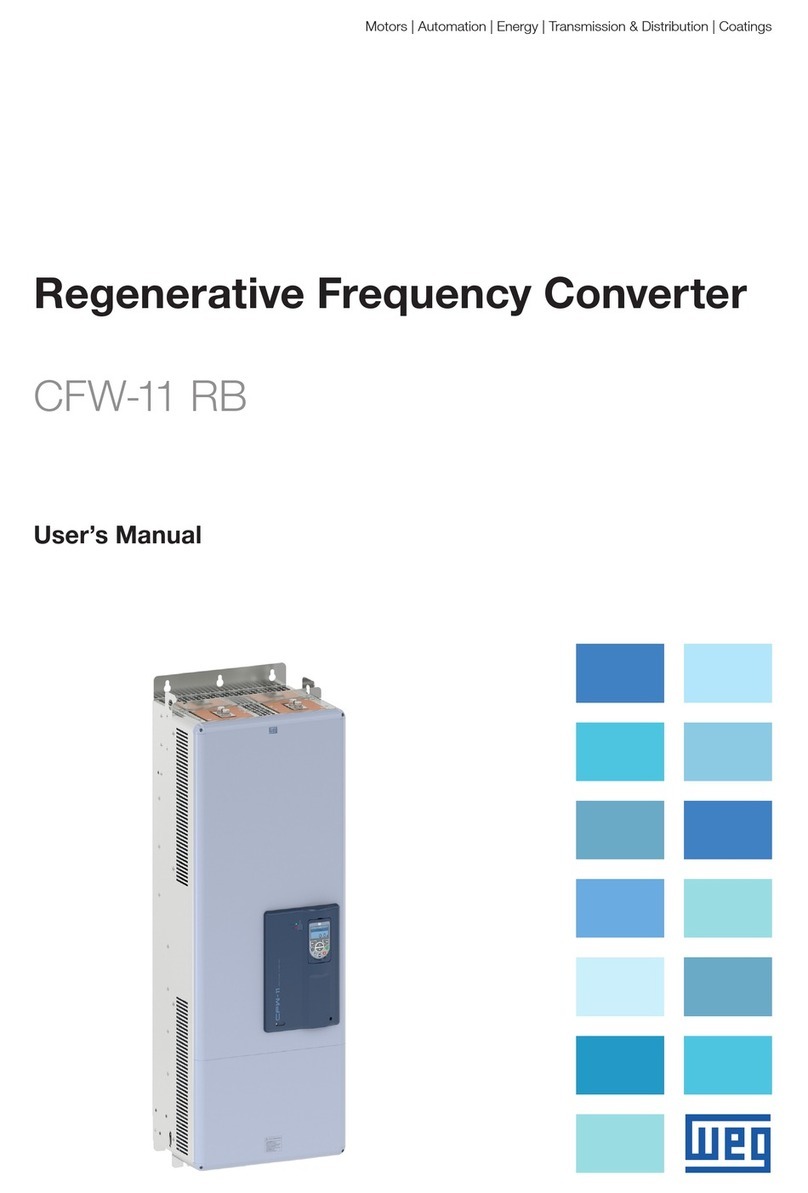ifi Pro iDSD User manual

User Manual
Pro iDSD

1
Thank you for purchasing this Pro series iDSD. The Pro iDSD is a 'state of the art' reference digital to
analog converter. lt is able to excel in many scenarios - as a wireless hi-res network player or the central
DAC in an expensive high-end home system, to quote just two examples. The on-board balanced
headphone section means high-end headphones can also be directly connected to it.
Features:
1. Quad-Core Burr Brown MultiBit/DSD hybrid DAC supporting DSD1024 and PCM768kHz
2. Studio grade DSD1024 remastering (Crysopeia FPGA Digital Engine)
3. Wireless DLNA/Airplay™/Ethernet Hi-Res Playback
4. User-selectable analogue stage: Tube or Solid-State
5. Master Quality Authenticated (MQA) playback
6. Global Master Timing femto grade clock system with external clock input options
7. Five lters: Bit-Perfect/Bit-Perfect+/Gibbs Transient Optimised/Apodising/Transient Aligned
8. Fully discrete passive LC analogue ltering
9. Zero Jitter Memory Buffer and Galvanic Isolation for all inputs
10. Discrete headphone/line amplier
11. Balanced inputs and outputs
12. Galvanic isolated ultra-quite power supply with super capacitors

Pr o
iDSD
Pr o
Input
/
90 18
Gain(dB)
+SE BAL
Filter
DSD 1024
Remaster ing
WPS
7.
1.
Headphone gain selection: 0dB/9dB/18dB
Headphone 6.3mm socket
Single-Ended 3.5mm headphone socket
LED indicator
Power
Input selector (incl. Brightness/Polarity)
Filter selector (incl. DSD Remastering/WPS)
Output mode: Solid-State/Tube/Tube+
2
P.8
1
23 5
6
8
11
2.
3.
4.
5.
P.4
8.
9.
P.4
P.4
P.5-6
P.7
P.8
P.8
12
9
4
7 10
OLED display
6.
Balanced 2.5mm headphone socket
10.
Analogue volume control (Line and
11.
IR remote control sensor
12.
Headphone outputs)
P.8
P.8
P.9
P.9

Techn ology l icens ed from A MR-A udio, U K
Ass emble d in Chin a
COAXIAL
OPTICAL Digital Inputs
RL
R
L
DC 15V/4A
XLR BNC
Sync In (USB)
Output Mode Sync Out
Outputs
Stand
Alone
DARS
Sync
Mode
DC Loop -Out
Pr o
Host Device
Pro ( Var)
Pro (Fixed )
HiFi ( Var)
HiFi (Fixe d)
3
XLR Balanced signal outputs
Single-Ended signal outputs
Output selector:
13
13.
14.
15.
P.9
P.9
P.9
P.12
P.12
14
15
16
17
18
19
20
21
22
23
26 27
24 25
Ethernet
Host USB
Device USB
16.
17.
18.
XLR Digital Input
19.
20.
21.
BNC Digital Input
Clock Sync mode:
Clock Sync output
23.
24.
25.
Coaxial/Optical Digital Input
Micro SDHC
22.
26.
27.
DC loop out supply
DC power supply connection
P.10
P.10
P.11
Analogue Outputs
Digital Inputs
Clock
P.10
P.10
P.10
P.11
P.11
P.12
P.12
(13 - 15)
(16 - 23)
(24 - 25)
Variable/Pro Fixed/Pro Variable Wi-Fi antenna
HiFi Fixed/HiFi
Atomic/DARS/1OMHz/Standalone

4
1. LED
Green: Warming Up
White: Solid-State Mode
Orange: Tube Mode
Red: Protection Mode
2. Standby/Power
3. Input selector
Use the selector to ’cycle’ through the following input options:
Also available via the input selector are:
- WiFi/Ethernet/Hard Disk/Micro SDHC
- Device USB (connect to a computer)
- Coaxial/Optical Digital Input
- XLR Digital Input
- BNC Digital Input
- Brightness (press to adjust)
- Polarity (hold to adjust)

4. Digital lter selection
The Pro iDSD offers the following three choices of digital processing:
i) Direct – Bit-Perfect
Both PCM and DSD signals are not processed in any way.
For PCM this is effectively what is sometimes called "non-oversampling" or "zero-oversampling". For
DSD it means the le is retained in the original DSD format and directly converted to analogue without
any digital processing.
ii) PCM - Upsampling
In this case PCM is up-converted to 16 x PCM (705.6/768kHz) using a choice of digital lters.
The following ve digital lters are available:
No digital ltering is applied, one tap'Bit-Perfect'
No digital ltering is applied, one tap, SINC roll-off is corrected'Bit-Perfect+'
Minimum ltering, no pre-ringing, minimum post ringing, 32 taps'Gibbs Transient Optimised'
Modest ltering, no pre-ringing, modest post ringing, 128 taps'Apodising'
Max ltering, max pre-ringing, maximum post-ringing, 16,384 taps'Transient Aligned'
The digital lter selections can be made 'on the y' to suit the listener's preferences.
5

Each lter effects a different time-domain and frequency-domain performance.
DSD remains completely unprocessed.
iii) DSD - Remastering
In this case incoming audio (except DSD512) is converted to either DSD512 or DSD1024 as selected,
using the lter selected (including Bit-Perfect, meaning no digital ltering is applied).
All these digital processing options apply to ALL sources, including the network audio bridge and AES-
EBU & S/PDIF inputs.
Inputs other than USB are currently limited to maximum sample rates of 192kHz PCM and DSD64 via DoP.
Please try all the different options to see which you enjoy the most.
Full Galvanic Isolation
All inputs are galvanically-isolated (including USB). The USB input is self-powered and does not draw
power from the USB bus. Therefore, the USB section is quite impervious to aftermarket add-ons or
tuning accessories.
WPS
For ease of use, simultaneously use the WPS button on the Pro iDSD and the router so that they can
both complete the handshake to pair up.
6

5. Output section mode: Solid-State / Tube / Tube+
The Pro iDSD (just like the Pro iCAN) is a one-of-a-kind product that is able to switch between:
'Solid-State' - a purely solid-state J-FET based circuit of fully-discrete Class A topology.
'Tube' - the J-FET circuitry is switched to an all-valve Class A section based on 2 x GE5670.
'Tube+' reduces available negative feedback to a minimum. As a result, a greater amount of the
tubes natural harmonic distortion is produced (even order harmonics dominate).
When switching, there is a momentary pause as the circuit switches over.
The audio circuit is a development of iFi's revolutionary 'TubeState' design. It is fully-discrete, fully-
balanced with either tube or J-FET input switchable, bipolar second stage and mosfet-buffered bipolar
Class A power stage (with Class AB for low impedance headphones and very high levels). The circuit is
fully DC coupled.
Please note that, due to the wear on the cathode of tubes after an extended period of time in solid-
state mode, the tube heater element will automatically power down and turn off the tubes. If the tube
heater is shut off when switching to tubes, they will need to warm-up again (as if the whole Pro iDSD
itself was powered up from cold). Music will continue to play via the solid-state section until the tubes
are ready.
This ensures maximum longevity for the NOS General Electric 5670 tubes.
+
7

6. OLED display
7. Headphone 3.5mm Single-Ended socket
3.5mm with TRRS iFi S-Balanced.
8. Headphone gain selection: 0dB/9dB/18dB
Always start from 0dB and then increase the gain level to attain an enjoyable and comfortable level of
volume from the headphones.
Warning: at the outset do not use excessive gain, otherwise damage to hearing or connected headphones
may ensue. AMR/iFi audio is not responsible for any damage/injury from misuse.
9. Headphone 6.3mm socket
10. Balanced 2.5mm headphone socket
2.5mm TRRS Balanced .headphones
if possible, always use balanced headphones to take full advantage of the true balanced nature Tip:
of the Pro iDSD circuitry.
8

11. Analogue Volume Control
At normal listening levels, the volume control should be around the 12 o'clock position. Increase the
gain level to enjoy a higher listening level.
12. Infrared Remote Receiver
Ÿ
Ÿ Window for infrared remote receiver signal.
Rear of Pro iDSD
Analogue Outputs
13. XLR Balanced signal outputs
Balanced signal output to an amplier.
14. Single-Ended signal outputs
Single-Ended signal output to an amplier.
15. Output selector: HiFi Fixed/HiFi Variable/Pro Fixed/Pro Variable
It is possible to set the signal output to different levels for home or studio use. Industry standard
signal output levels apply; balanced output is ~4.6V (HiFi Fixed mode) and ~11.2V (Pro Fixed mode).
Variable is adjusted via the front volume control. With the volume control at maximum the same
signal levels listed above are achieved.
9

Digital Inputs
16. Ethernet
For a wired connection directly from a router or Network Attached Storage (NAS) source. Using the
MUZO Player app stream Spotify (incl. Connect), TIDAL, Napster, QQ Music and many more.
17. Source Host USB 'Type A’
For connecting an external hard disk drive (HDD, FAT32), USB memory stick or similar to play music,
classic hard drives should be formatted as FAT32 and self-powered from an external power supply.
All les from MP3 to FLAC to DSD(*) can be played directly through the Pro iDSD via the MUZO Player
app.
18. DAC USB 'Type B’
For connecting a PC host such as a laptop or a server.
19. Coaxial/Digital Input
For connecting an S/PDIF source such as a high-end CD transport.
20. Micro SDHC
Insert a Micro SDHC card with music les. All les from MP3 to FLAC to DSD(*) can be played directly
through the Pro iDSD via the MUZO Player app.
10

21. AES/EBU (XLR) digital input
For connecting an XLR single link source such as a high-end CD transport or a Digital Audio
Workstation (DAW).
22. Wi-Fi antenna
Using the MUZO Player app, connect the Pro iDSD to the local WiFi system to stream Spotify, TIDAL,
Napster, QQ Music and many more.
It is also possible to enjoy Airplay network audio playback from iPhone, iPad and Mac computers.
Wirelessly, just about every music format up to 192kHz/32-Bit from MP3 to FLAC to DSD(*) can be
played directly through the Pro iDSD via the MUZO Player app or suitable server software.
23. BNC digital input
BNC multifunction input (S/PDIF/AES3id) such as from a high-end CD transport. For clock
synchronization in recording studios, the Pro iDSD supports AES3id based DARS (Digital Audio
Reference Signal) according to AES11.
* DSD les must be encoded as so-called DoP-FLAC Files
It is equally possible to use an atomic reference clock (at least Sanford Research Systems PERF10
should be used) to further elevate the Pro iDSD performance over the internal clock system.
11

Clock
24. Clock Synch mode: Atomic/DARS/10MHz/Standalone
If the Clock Synch mode is used, please select the correct clock device.
Atomic Clock: Connect to an external atomic clock source.
DARS: Digital Audio Reference Signal, connect to an external DARS clock reference (it is a
S/PDIF signal without any actual audio data).
10MHz: Connect a 10MHz external clock to the BNC Sync In to synchronise with the rest
of the system. BNC Sync Out will output a 10MHz clock even if no external 10MHz
clock is connected.
Standalone: No external clock source is used.
25. Output
BNC multifunction Sync Out (DARS out, 10MHz out), selection via Clock Sync mode switch.
26. DC Loop-Out
DC loop through for use with other Pro series products (e.g. Pro iCAN).
27. Power supply connection
15V/4A DC power input.
Tip: Any 9v to 18v DC power source with a minimum of 60VA rating can be used with the Pro iDSD (including vehicular, RV and boat based
12V DC power). We strongly recommend the use of the included iPower Plus 15v. It offers the latest in power supply technology and is
better and cleaner than any battery or aftermarket linear power supply.
12

Design Notes from the AMR/iFi Research & Development department
The Pro iDSD is an all-out assault on the state-of-the-art and its ground breaking digital engine will be used across
the next generation of iFi products.
1) DAC section
The Pro iDSD uses a quad 'core' of iFi audio's bit-perfect DSD & DXD DAC by Burr-Brown in a custom 'interleaved'
conguration. A total of eight pairs (four for each channel) of differential signals are used and mixed.
While the Pro iDSD does include an FPGA for digital lter duties, the FPGAs themselves do not perform d/a
conversion. There are always external d/a sections, with a limited number of elements. In the Pro iDSD we use four
interleaved 64-element converters, to give a total of 256 element DAC per channel, manufactured to the highest
level of precision. Discrete DACs added can neither offer those elements' numbers nor the accuracy required.
All signals to the DACs are re-clocked with the low-jitter Global Master Timing® derived master clock from the AMR
DP-777.
2) Digital Processing
Bitperfect or Upsampled
All digital processing is bit-perfect, without employing ASRC or up conversion unless digital filters embedded the Crysopeia
FPGA remastering engine are explicitly selected. Divergent digital filters (including bit-perfect mode without digital
filtering) are selectable and operate in synchronous mode.
13

14
The Pro iDSD uses the second generation XMOS XU216 X-Core 200 Series 16-core processor with a maximum of 2,000
MIPS (two billion instructions per second) calculation power in dual-issue mode as USB interface.
The X-Core 200 handles decoding of signals from all Inputs, be it USB (up to 768kHz/DSD512), AES/EBU or S/PDIF (up to
192kHz/24Bit) and WiFi/network/mass-storage (up to 192kHz/32Bit).
Hi-res Network Audio
In addition to traditional inputs, the Pro iDSD integrates a WiFi/network playback system, with built-in Spotify and
Tidal (and other streaming services), wide protocol support including Airplay and USB memory/HDD/SD card
playback to make a full standalone streamer/network audio player with 32 bit/192kHz & DSD64 support.
The following playback options are available with the Pro iDSD:
• Airplay network audio playback from iPhone, iPad and Mac computers
• DLNA network audio playback from smartphones, tablets and Windows/Linux computers
• Playback from a hard disk drive (HDD), USB memory or SDHC memory card
• Playback from Network Attached Storage (NAS)
• Streaming playback includes Spotify, TIDAL, Napster, QQ Music and others
• The Pro iDSD is a agship, hence it has MQA decoding on-board for the maximum quality of playback, be it on
MQA music les or streaming.

15
Zero Jitter Memory Buffer for all inputs
Data for all inputs is sent to a large 'dynamic' memory buffer, where it is de-jittered to eliminate any transmission of
source jitter to the DAC output. The memory buffer data is then re-clocked by the low-jitter Global Master Timing®
clock, which also drives the X-Core 200 & FPGA engine.
Studio Grade DSD1024 Remastering
While the X-Core 200 is optimal for USB audio, AES/EBU/S/PDIF, MQA, DSD etc. decoding, it is not the best platform
for DSP, digital lters and PCM-to-DSD conversion.
The other half of the digital processing is carried out by the Crysopeia FPGA engine. It handles digital ltering and
PCM-to-DSD remastering up to DSD1024. We believe that FPGA excels in upsampling and digital ltering duties.
On-board hardware upsampling allows us to not only overcome the current DSD512 USB limitation, but also to implement
multiple filters optimized for specific time-domain behavior related to both stages; digital and analogue. This level of
optimization is simply not possible in generic software upconversion (as found in i.e. Foobar 2000).

There are ve lters available:
'Bit-Perfect' No digital ltering is applied, one tap
'Bit-Perfect+' No digital ltering is applied, one tap, SINC roll-off is corrected
'Gibbs Transient Optimised' Minimum ltering, no pre-ringing, minimum post ringing, 32 taps
'Apodising' Modest ltering, no pre-ringing, modest post ringing, 128 taps
'Transient Aligned' Max ltering, max pre-ringing, maximum post-ringing, 16,384 taps
Full Galvanic Isolation
All inputs are galvanically-isolated (including USB). The USB input is self-powered and does not draw power from
the USB bus. The USB section is quite impervious to aftermarket add-ons or tuning accessories. The isolation barrier
is placed not in the inputs but instead between the relatively noisy digital processing section and the clock /
reclocker / DAC section, so not only USB related but all digital noise is isolated.
Cutting-Edge S/PDIF
The S/PDIF inputs use the technology derived from the AMR DP-777; a brand new solid-state HD-VDi
implementation, memory buffer and the Global Master Timing® clock system. Given this extreme attention to jitter
reduction, the S/PDIF inputs benet little from additional tweaks or tuning gizmos.
External Clock options & Synchronisation
For the purpose of synchronization in recording studios, the Pro iDSD supports AES3id based DARS (Digital Audio
Reference Signal) according to AES11. And if you happen to have a really good atomic clock (of Sanford Research
Systems PERF10 quality or higher), it can be used to further elevate the Pro iDSD's already impressive internal clock
system performance. This is very much an over-specied approach, yet the iFi agship deserves this feature in order
to be as future-proof as possible.
16

17
3) Passive Filtering and Discrete Analogue stage
Each d/a converter operates in the 'voltage output mode', giving >119dB dynamic range. All ltering is passive. A
fully-balanced 3rd order capacitor/inductor/capacitor lter is used to remove ultrasonic noise directly after the d/a
conversion rather than active, feedback-based circuits.
Active lters struggle with the amount of ultrasonic noise and RFI they have to handle and at a few 100kHz they
often lose the ability to lter noise at all, which is precisely where a lot of it is present.
Passive CLC circuitry in the Pro iDSD provides the correct ltering well into the MHz region, so that the follow-on
analogue stage is not required to handle ultrasonic noise and RFI originating within the DAC processes.
An all-analogue six-track Japanese Alps potentiometer is to be found directly after DAC and lter stages. It can be
bypassed if volume control is not required.
The actual analogue circuitry is more precisely a line/headphone driver stage. First seen in the Pro iCAN, it's fully
balanced and 100% discrete, direct-coupled (without coupling capacitors) and tube/solid-state user-selectable.
Our design is not just op-amp based discrete but radically different - pure Class A topology. It was inspired by
exceptional sounding, legendary studio equipment.

4) Power Supplies
All incoming DC is converted to a high-frequency waveform and then rectied and ltered by a choke input
capacitor lter (that is straight out of classic tube design, brought up to the latest 21st century technology).
This produces a rst-level DC bus from which all further voltages are derived. This circuit also generates a
galvanically-isolated power supply voltage for the USB input circuitry.
The digital section is powered by a bank of ELNA Dynacap DZ (TM) super capacitors of 6.6 Farad (6,600,000uF) value
in total. ELNA Dynacap DZ (TM) super capacitors have around 400x lower internal impedance (in comparison to
similar products of regular grade) and are used to avoid the typical drawback of the very high internal impedance of
common 'super capacitors'.
Individual low-noise TI LDO regulators with local LC ltering provide the nal low-noise power for all individual
digital sections. A total of six individual regulators cover clock, S/PDIF input and the digital section. The analogue
side of the DAC is supplied with ultra-low noise super-regulators based on iFi audio's custom ultra-low noise
OV2028 operational amplier.
The USB input section has its own separate power management system with multiple regulators and ltering
operating from the galvanically-isolated voltage generated to power this section.
Higher voltages (especially for the tubes) are required for the analogue stage, which in effect operates on 60V rail
providing massive potential dynamic range. These are generated from the main DC bus and are ltered via multiple
inductor/capacitor stages based on great Elna Silmic capacitors.
18

Every section in the Pro iDSD has received massive attention to detail. Classic, very low-noise design techniques
found in tube equipment have been combined with 21st century tech to deliver extreme performance.
Specications
Sample rates: PCM up to 768kHz
DSD up to 49.152MHz (DSD 1024)
DXD and double-speed DXD (2xDXD)
Inputs: USB (required for DSD, DXD and sample rates above 192KHz)
AES3 (XLR - single link)
S/PDIF (coaxial/optical combo)
BNC multifunction (S/PDIF in or sync input)
Outputs: Balanced XLR at 4.6V (+15dBu - HiFi) or 11.2V (+22dBu - Pro)
Single-Ended RCA at 2.3V (HiFi) or 5.6V (Pro)
Headphones 6.3mm jack at 5.6V or 11.2V maximum (always with volume control)
Headphones out 1,500mW RMS x 2 @ 64 ohm, 4,000mW max. x 2 @ 16 ohm
Volume control: Balanced (6-gang) Alps potentiometer, motorised with IR remote control
XLR/RCA outputs can be selected as xed level or adjusted
6.3mm headphone jack is always adjusted
Other Functions: Various digital and analogue lters can be selected for DSD and PCM up to 384KHz
19
Table of contents
Other ifi Media Converter manuals
Popular Media Converter manuals by other brands
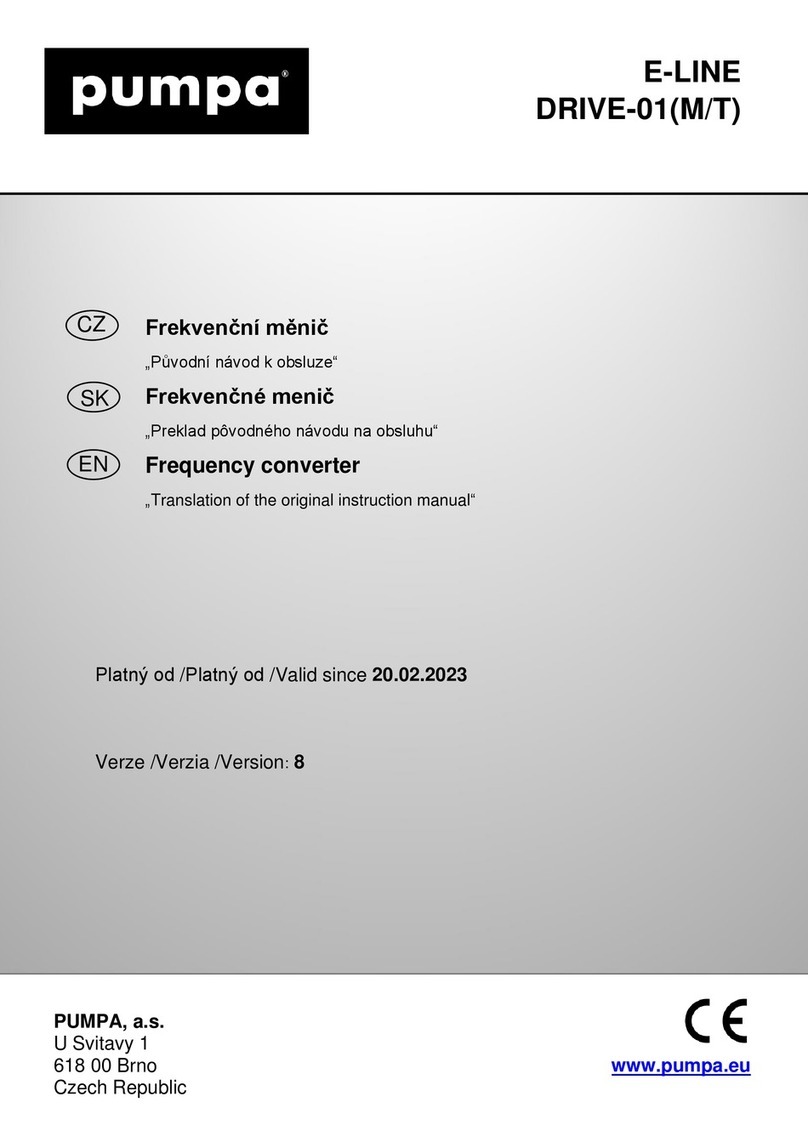
pumpa
pumpa E-LINE DRIVE-01 Translation of the original instruction manual
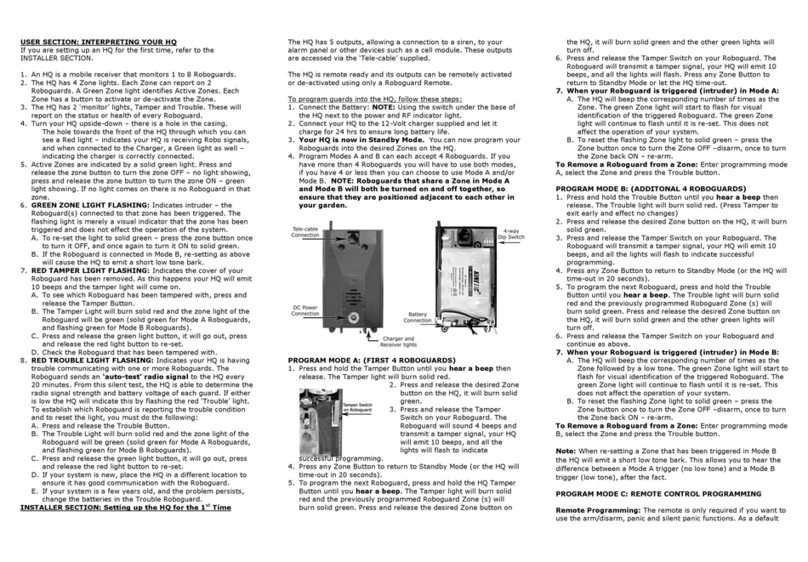
RoboGuard
RoboGuard HQ user manual
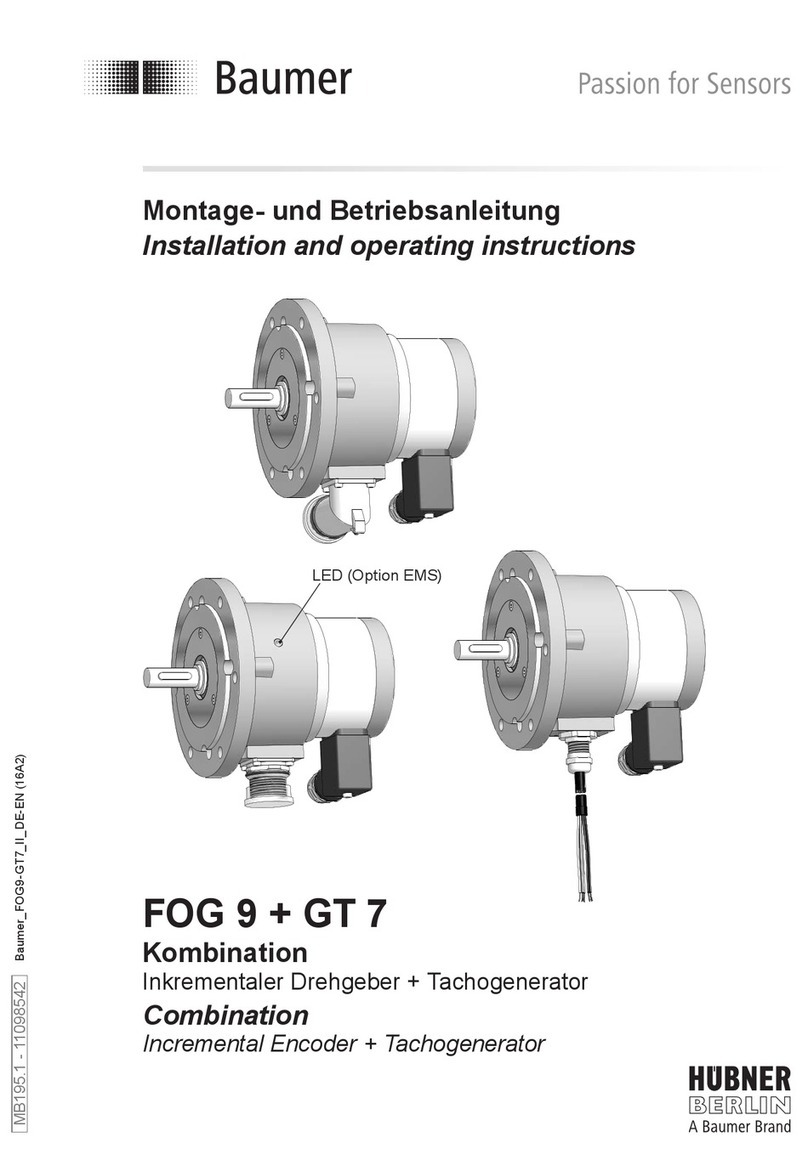
Baumer
Baumer Hubner FOG 9 + GT 7 Installation and operating instructions
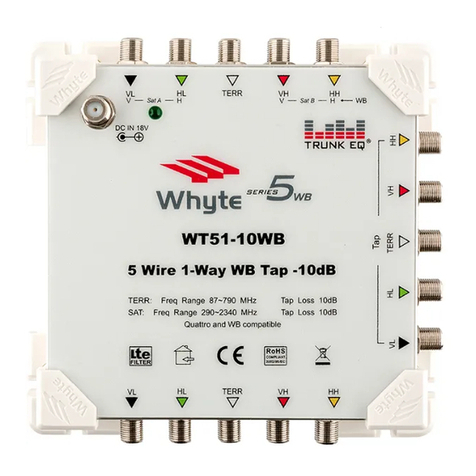
Whyte
Whyte WT51-10WB instruction manual
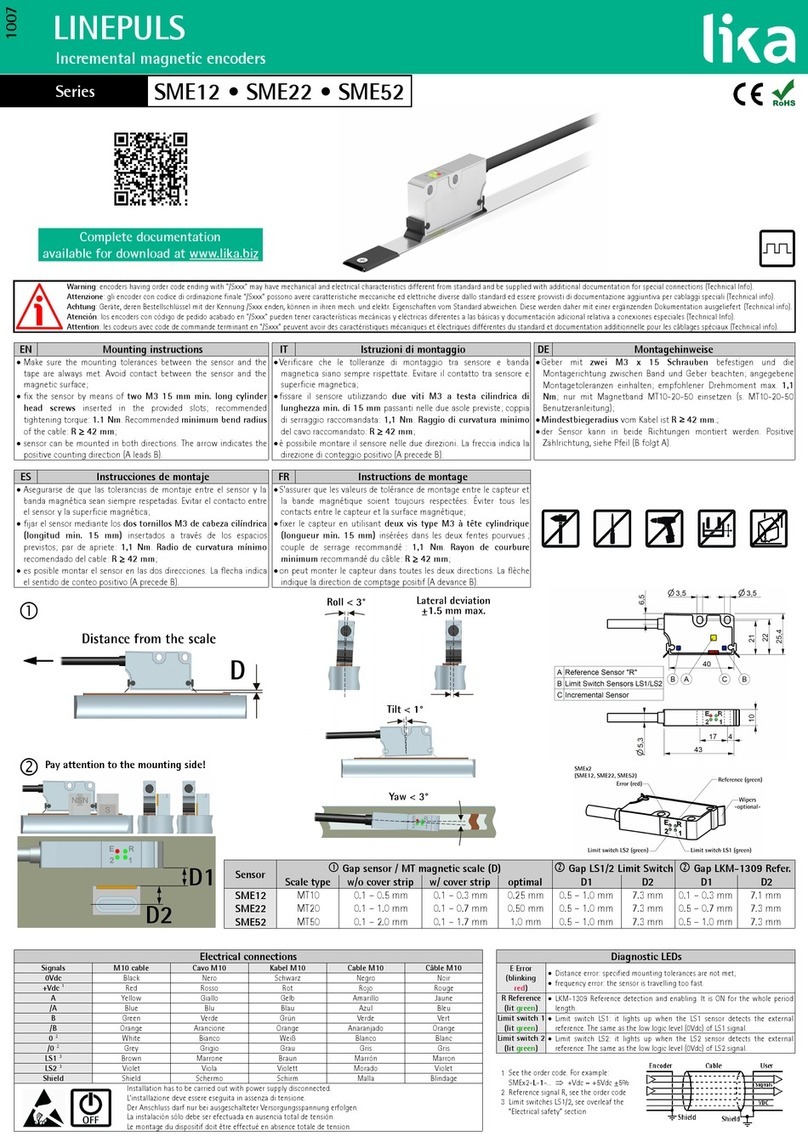
Lika
Lika Linepuls SME52 Series manual
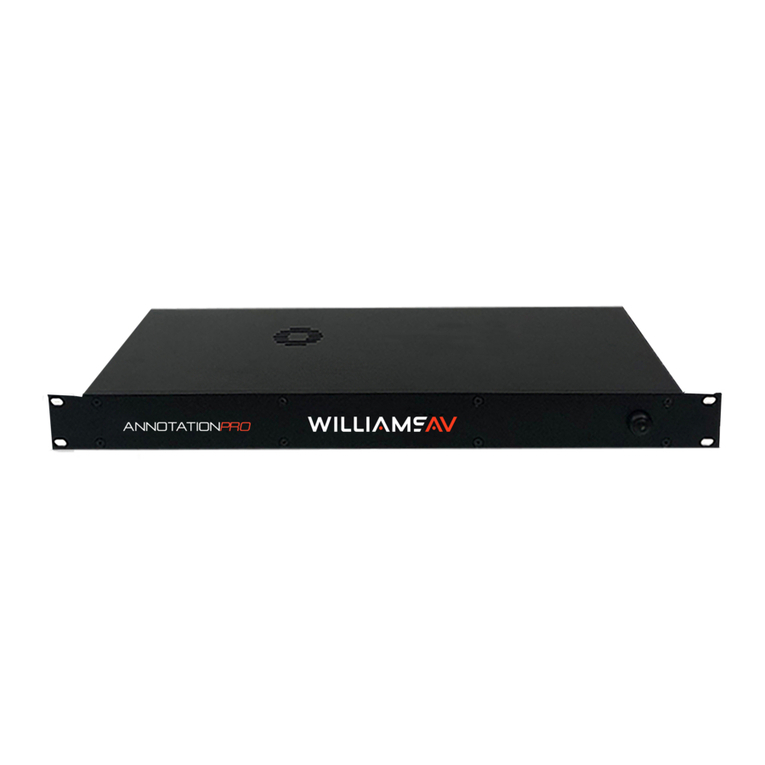
Williams AV
Williams AV Annotation Pro user manual
